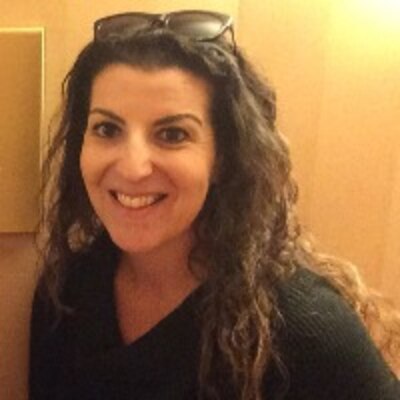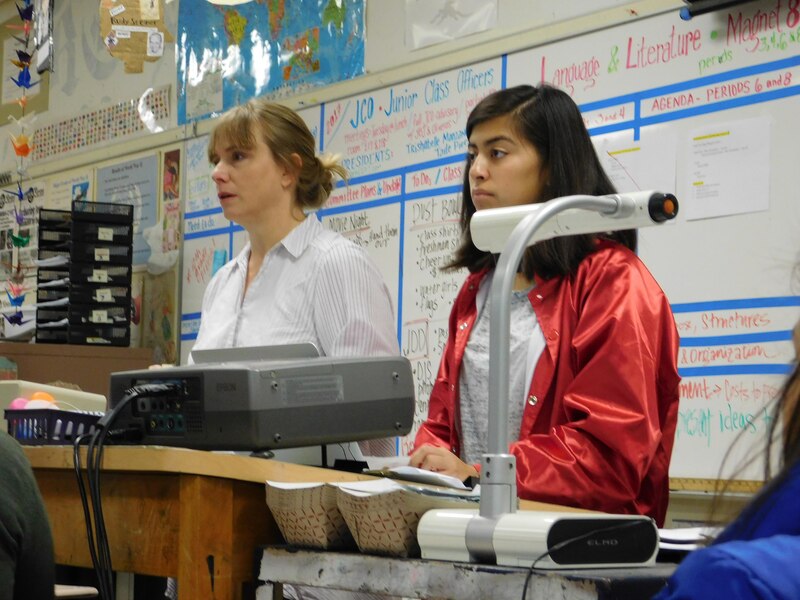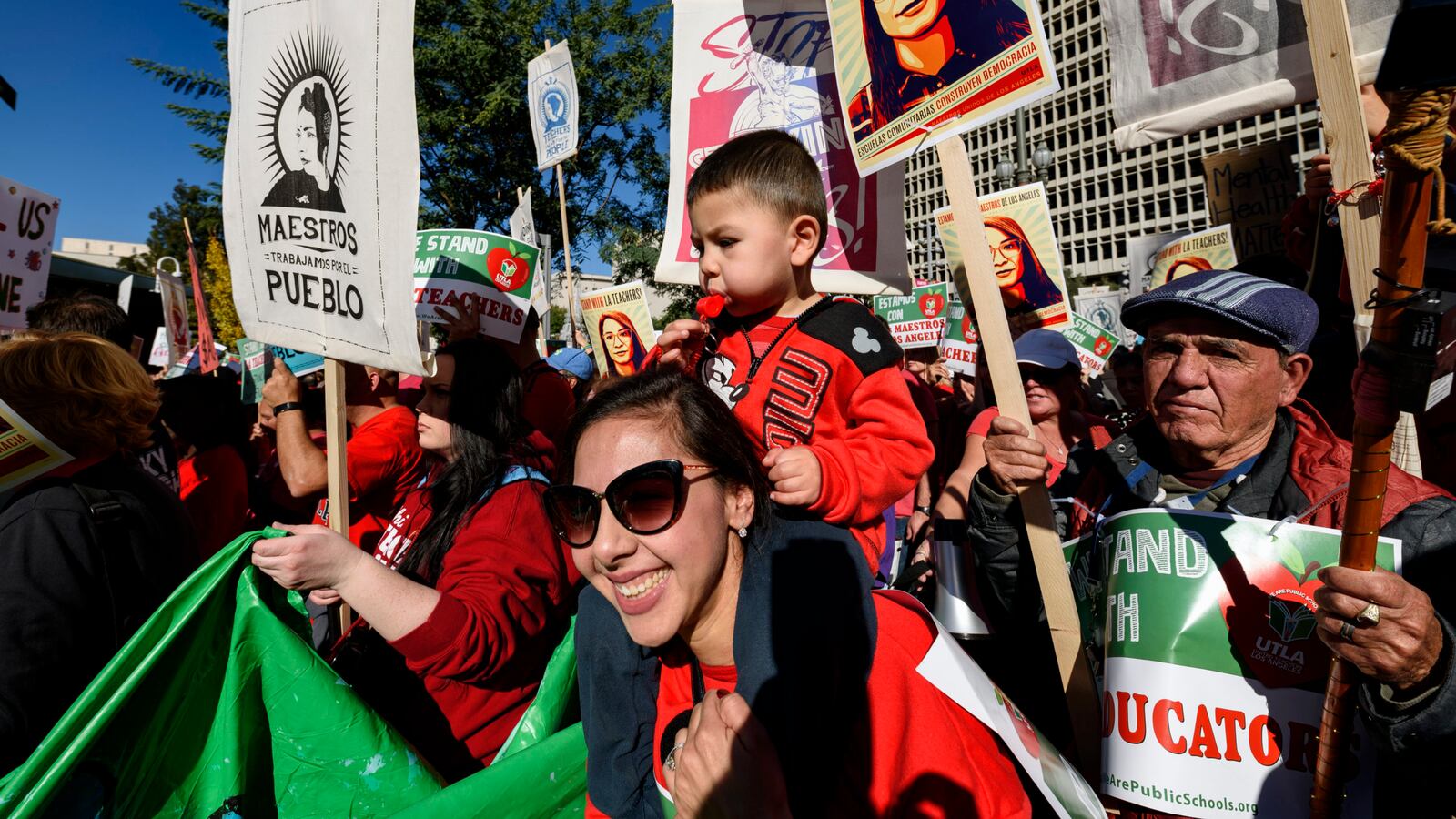America’s second-largest school district appears headed for a teachers’ strike, with more than 30,000 Los Angeles educators prepared to walk out as early as Thursday.
Contract negotiations between the teachers union and Los Angeles Unified School District have reached an impasse over class sizes, charter schools, funding for additional counselors, nurses, and librarians, and how to spend down the district’s $1.7 billion reserves.
It’s a thorny tangle of issues. So Chalkbeat asked five teachers to explain which ones they’re thinking about most this week, and whether they feel connected to the broader national “Red for Ed” movement for higher teacher salaries and more school funding.
For this cross-section of teachers, smaller class sizes and more school nurses and counselors mattered most. Pay was top of mind for a few but was not widely cited as a sticking point. (L.A. Unified, which serves some 620,000 students, has offered teachers a 6 percent salary increase. But the district contends it would go broke were it to meet some of the union’s other demands — something the union, United Teachers Los Angeles, refutes.)
Several teachers who spoke to Chalkbeat felt aggrieved by the expansion of charter schools — including a teacher at one of Los Angeles’s district-affiliated charters. All of them felt some connection to the national teacher-protest movement.
“We have a huge part of the national population, so I think people want to know what’s going on here in Los Angeles because that will likely be mirrored in the country,” said Michelle Youngblood Jarman, a literature teacher at Eagle Rock Junior-Senior High School.
Answers have been edited for length and clarity.
What issue or issues under negotiation matter most to you?

Rafael Jimeno, teaches sixth-grade math and world art at Southeast DREAMS Magnet Middle School in South Gate: I think the top three would be lowering class sizes; the need for more counselors, nurses, and psychologists; and raising wages to close the gap with inflation.
Any teacher, but especially the ones in places like South Los Angeles, sees that students come to our classrooms with a lot of trauma that they bring from home. It could be the death of a parent or a loved one, it could be violence, it could be poverty or hunger. You can’t effectively cover content and at the same time give students the emotional and psychological supports that they need to contend with those things they bring into our classroom.
We’re not going to attract all these bright, energetic young teachers to our classrooms if our salaries aren’t competitive with what a graduate could get in the private sector. It’s not like any teacher goes into it thinking they are going to be rich, but the gap can’t [be] so wide as to be unreasonable.

Pat Lingard, teaches kindergarten at Castlebay Lane Charter School, a district-affiliated charter school in Porter Ranch: For me, there [are] two aspects that are most important in this negotiation. The first is to make sure our schools are fully funded. They deserve a nurse and a psychologist and lower class sizes and aides in the classroom and a librarian in the library and a music teacher and an art teacher. Those are all fundamental components to a successful education.
The other part of it for me, which is as important, is to prevent the privatization of public education, which is a big part of what this negotiation is about. The more private charters that are allowed to co-locate on our campuses, that draws students away from our public school system and draws money away from our public school funding.

Jennifer Harmon, teaches fifth grade at Kester Magnet in Sherman Oaks: The biggest issue, for me, is class size. In the magnet program, the fourth and fifth grades cap out at 34, which is quite a lot of kids. In non-magnet schools, class sizes can be even higher. One teacher, no aides, no additional support staff involved. We want a section of our contract deleted that says that in times of financial crisis, LAUSD can ignore state class-size caps. Every year it feels like L.A. Unified says it’s in a crisis.
If I’m doing a math lesson, say, for 35 kids in my class, sometimes it’s difficult to pinpoint those students who are having difficulty with the concept or standard until later on, and then it’s hard to go back and re-teach it in a meaningful way. And as an elementary school teacher, it’s really important to make personal connections with your students and sometimes that’s hard to do when you have so many kids — especially when they are kids who need a lot.

Michelle Youngblood Jarman, teaches literature and language at Eagle Rock Junior-Senior High School in Eagle Rock: The cost of living has gone up so much, and it’s really difficult for the district for the district to pay so much in salaries. I do think 6 percent is really reasonable — I don’t think that’s a sticking factor at all.
An issue for teachers in some schools is high class size. It’s eked up from a reasonable number to something that’s out of control. I have more than 40 [students] in several of my classes. It’s impossible to really wrap your head and your heart around really getting to know that child’s needs. Another big issue is that a nurse isn’t on campus. Our school of 2,500 was given a nurse one day a week. It’s not reasonable.

Leonard Goldberg, teaches sixth-grade math and science at Olive Vista Middle School in Sylmar: It’s not the money. If I had gotten into education for the money, boy, did I make a mistake for the last 30 years. What’s challenging to me right now is the unraveling of public education. I see a drain of money leaving our district and going to unregulated charter schools — which is not to say all charter schools are bad. What I’m saying is we’re taking taxpayer money and it is not being held to the same standard that my school is being held accountable to.
[Another issue is having] a nurse five days a week to help students who need to take medications and have them properly dispensed, or, heaven forbid, an accident; a full-time librarian; counselors with a caseload to instead of putting out fires and behavioral issues and instead of being reactive, they can be proactive. Right now, the number of students they need to service is crazy.
What’s one thing readers might not know about what it’s like to be a public school teacher in Los Angeles?
Jimeno: There will be people who will talk about “our failing schools.” But when you’re in the district, when you’re meeting all the people who compose the individual school sites, you have so many passionate, devoted, caring people who are doing their absolute level best to help students meet their own goals to provide them a quality education. All of that goodwill and all of that passion gets buried in data.
Lingard: Being a public school educator — it’s not a formula. You are dealing with living/breathing humans who come with all kinds of family traumas and issues and all different backgrounds. It takes working weekends, getting there and early, working late, working through lunch and recess, and taking classes in the summertime and on weeks.
Harmon: We’re really lucky in my school, where I feel supported by my administrator and by my grade-level colleagues. But there’s a lot we have to figure out on our own, especially when we’re moving to new programs or new sets of standards we have to teach — and there’s really a lack of support, training, and guidance from the district. That part is really difficult. We don’t have any new science textbooks, we don’t have any new supplies, and we’ve had virtually no professional development to teach the Next Generation Science Standards.
Youngblood Jarman: I think a lot of people would be surprised at what is not funded, such as the nurses or counselors. Most people are surprised by our hours. I often work 7 a.m. to 5 p.m., even to 6, 7, 8. People who don’t see the daily life of a teacher wouldn’t realize how much is put into it.
Goldberg: I don’t know how much of the public realizes how much money I spend out of my own pocket — and not just myself, but my fellow teachers at my school and schools across LA Unified [on] everyday supplies like pencils and erasers, notebooks, and backpacks for students who do not have them or cannot afford them. I probably spend $200 to $500 a month.

Do you see this contract fight as being connected to the Red For Ed movement?
Jimeno: In many ways, it’s in the same spirit, but the key difference is what drove all these educators to the streets was that in these other states, unions either didn’t exist or had been severely weakened by legislation. That’s the difference: We’re lucky we have a very strong union that is continually in the process of making sure our district does right by our students and by teachers.
Lingard: I think that our struggles are very similar in a lot of ways to the struggles all the school districts are facing — funding is not sufficient, supports are not sufficient. We’re reaching a point nationally where we realize that if we don’t do something now, our public education is in serious trouble.
Harmon: I think it’s completely aligned. Nobody wants to go on strike, but it’s a fight worth fighting for the kids we have now and the kids in the future. I think that what has been going on in some of the other states in the nation is really picking up speed — and is helping to give voice to teachers that, maybe, we didn’t realize that we had that voice within us.
Youngblood Jarman: I was elected [as a representative] to the California Teachers Association and to the National Education Association, so I see the larger picture more than other teachers might. A lot of people are looking to California and what’s going to happen with charters, a lot of people are looking at the allocation for education in general. We have a huge part of the national population, so I think people want to know what’s going on here in Los Angeles because that will likely be mirrored in the country. To me, ideally, LAUSD and UTLA would work together, not just on our contract but also on our advocacy for public education spending. We really need to be on the same page and go to Sacramento and advocate together.
Goldberg: It’s education as a whole, and especially in the state of California. We’re the [world’s] fifth-largest economy and yet we’re underfunding schools. The folks who need to do the heavy lifting are the folks in the trenches — the teachers, the counselors, the librarians, the support staff. It’s time we speak up, not for ourselves to get a raise, but for the rights of our students who deserve a quality education in our schools. My brothers and sisters are uniting across America to say enough is enough.
Francisco Vara-Orta contributed reporting.


